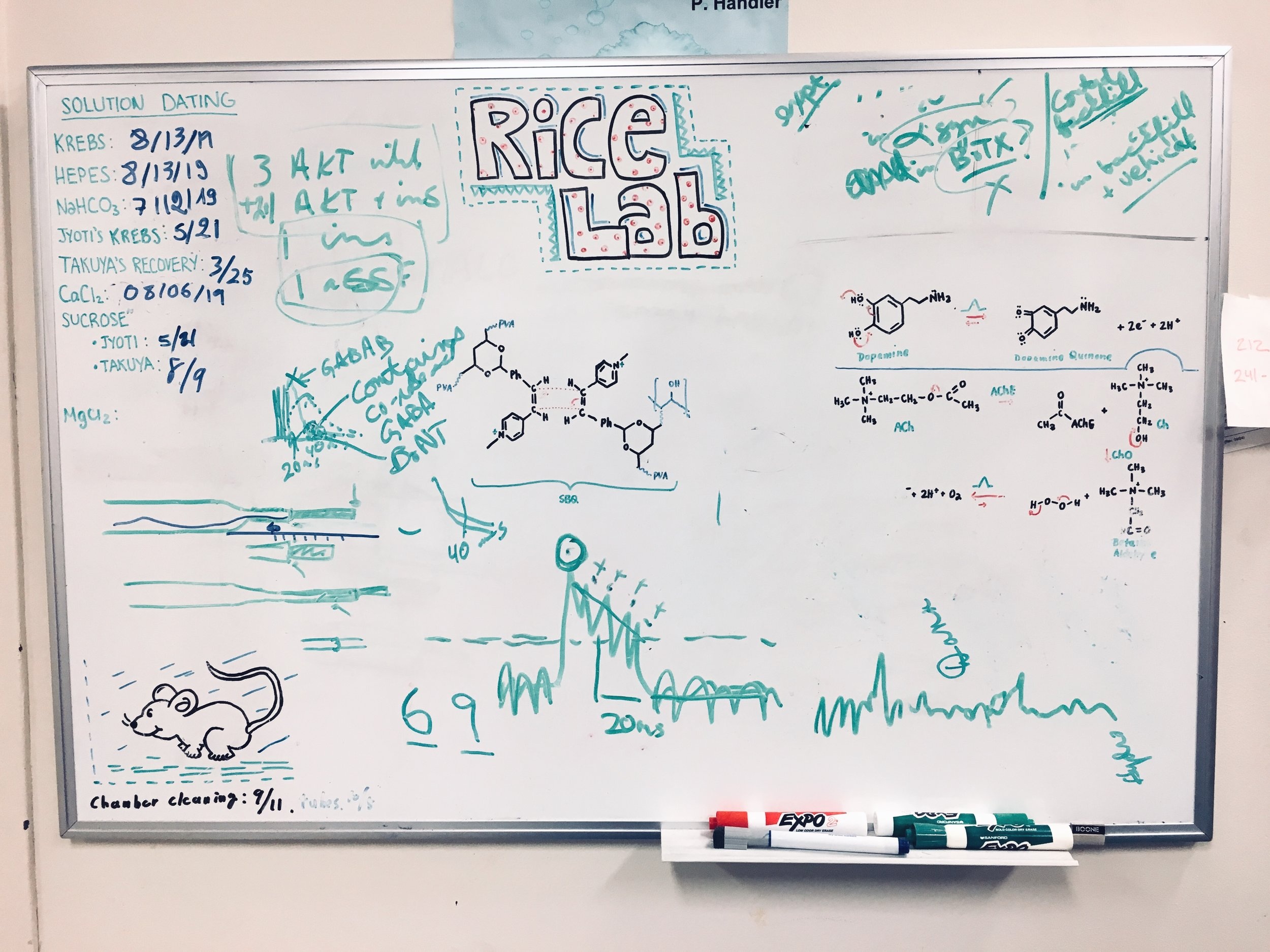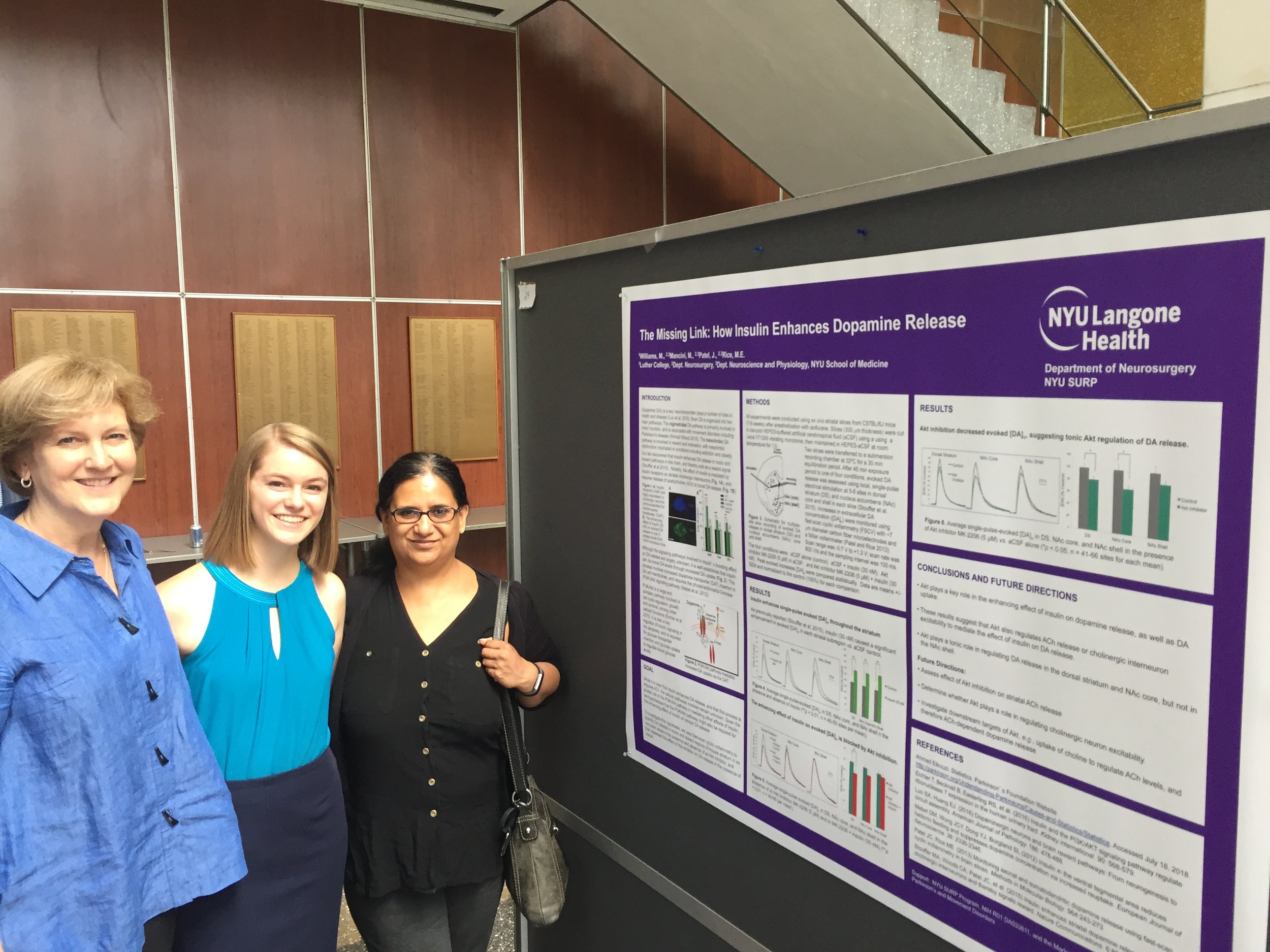
The Rice Lab Studies FACTORS THAT GOVERN DYNAMIC, LOCAL DOPAMINE RELEASE.
Dopamine (DA) transmission plays a critical role in motor and reward learning through two major pathways connecting the midbrain to the distant striatal complex. The nigrostriatal pathway projects from the substantia nigra pars compacta (SNc) to the dorsal striatum, where the axonal arbor of single DA neuron can extend over 6% of striatal volume. Loss of SNc DA underlies the basal ganglia dysfunction and the motor deficits observed during Parkinson's disease. The parallel mesolimbic pathway projects from the ventral tegmental area (VTA) to the ventral striatum (nucleus accumbens [NAc] shell and core). In the NAc, an increase in the frequency of phasic DA release has been shown to accompany the motivational and reinforcing properties of drugs, food, and other rewarding stimuli.
Within target striatal regions, DA release occurs from DA axons. Notably, however, midbrain DA neurons also release DA from their cell bodies (somata) and dendrites, in a process known as somatodendritic release. Because DA receptors and the DA transporter (DAT) are largely extrasynaptic, DA release relies predominantly on volume transmission and thus depends on regionally dependent diffusion and uptake characteristics.
Research in the Rice Lab is focused on elucidating factors that provide local regulation of axonal and somatodendritic DA release. The primary method in the Rice group to detect DA release is fast-scan cyclic voltammetry (FSCV), complemented by whole-cell patch clamp recording, fluorescence imaging, and immunohistochemistry. Most studies are conducted in ex vivo rodent brain slices, which are used to provide insight into local regulation of DA release and uptake without the confounding influence of feedback from longer pathways and brain circuits.
Ongoing Projects
Insulin is a reward signal that enhances striatal DA release via cholinergic interneurons
Striatal DA plays key roles in modulating motor and reward behaviors. DA release from striatal axons is often assumed to be governed exclusively by the firing pattern of midbrain dopamine neurons. However, it is also strongly influenced by local transmitters, especially acetylcholine (ACh) (e.g., Rice and Cragg 2004), as well as by extrinsic factors, like insulin. During and after we eat, we experience a sustained increase in plasma insulin, which activates insulin receptors (InsRs) in the hypothalamus and communicates with appetitive circuits to decrease eating. However, the rising incidence of obesity and Type II diabetes, which results in chronically high levels of insulin, suggests that there may be competitive reward circuitry regulating the motivational and rewarding properties of food.
The nucleus accumbens (NAc) has been shown to mediate the anticipation of rewarding food or drugs, while the caudate-putamen (CPu) has been proposed to play a role in habit-formation and craving. On-going work in the Rice Lab has shown that insulin can amplify action potential-dependent DA release in the NAc and CPu.
Indeed, ACh-dopamine interactions are central to the influence of peripherally derived insulin in the striatum through an indirect mechanism that involves striatal cholinergic interneurons (ChIs) that express InsRs (Stouffer et al., 2015). At physiological concentrations (nM), insulin enhances evoked DA release in ex vivo striatal slices, monitored using FSCV. This enhancement requires ACh and nAChRs, as the effect is lost in striatal slices from mice with forebrain ACh deletion, or after pharmacological antagonism of nAChRs. Further implicating ChIs in this process, insulin increases ChI excitability via insulin receptors on these cells. The amplification of DA release by insulin suggests a role for this neuropeptide as a reward signal, which complements its well-established role in satiety.
Insulin receptors (InsRs) on striatal cholinergic interneuron (ChI). Electrophysiologically identified ChI triple labelled for biocyin (red, from the recording pipette), acetylcholine synthesis (blue, choline acetyltransferase, ChAT), and InsRs (green). Activation of InsRs increases ChI excitability and enhances release of dopamine, a key reward pathway transmitter. Adapted from Stouffer et al., 2015.
Insulin receptors (InsRs) on a striatal cholinergic interneuron (ChI). ChI identified by immunolabelling acetylcholine synthesis (blue, choline acetyltransferase) expresses InsRs. Activation of InsRs increases ChI excitability and enhances DA release. Adapted from Stouffer et al., 2015.
Insulin boosts striatal dopamine release by activating cholinergic interneurons, and thereby influences food choice.
Companion behavioral studies done in collaboration with Kenneth Carr’s lab at NYU show that intact insulin signaling conveys the nutritive value of what we ingest, and thereby reinforces preference for high sugar substances. Together, these data reveal the key roles of local modulation of dopamine within the striatum in mediating the influence of insulin on motivation. Current studies include addressing the pathways and ion channels involved in activation of ChIs by insulin using whole-cell recording. We are also working on refining an enzyme electrode to detect ACh.
LEPTIN PROMOTES DOPAMINE RELEASE IN THE NIGROSTRIATAL and mesolimbic PATHWAYs
Left. Leptin receptor (red) expression in SNc dopamine neurons (blue). Right. Leptin increases the spontaneous activity of SNc dopamine neurons.
Like insulin, leptin (a satiety hormone) also enhances striatal dopamine release in both dorsal and ventral striatum in ex vivo brain slices. In contrast to the effect of exercise, however, the influence of leptin is entirely dependent on the boosting of dopamine release by ACh. Leptin has no effect on dopamine release in slices from mice that lack ACh synthesis, or when ACh receptors are blocked.Further mechanistic studies implicate an increase in intracellular calcium amplifying DA release. On-going studies are investigating the influence of leptin on DA neurons of the substantia nigra, as well as how leptin regulation of DA release changes with exercise.
The Influence of Exercise on Nigrostriatal and mesolimbic Dopamine Regulation and release
Exercise has been shown to increase levels of brain-derived neurotrophic factor (BDNF) in rodent hippocampus. However, the influence of exercise on striatal DA release and its possible regulation by BDNF are poorly understood. Our recent results indicated that mice allowed free access to running wheels for 30 days led to a significant increase in dynamic striatal DA release in brain slices from runners vs. mice with a fixed wheel in their cages. As striatal DA release is potently regulated by another striatal neurotransmitter, acetylcholine (ACh), parallel studies examined whether the runner/non-runner difference involved indirect boosting by ACh, or whether it was a direct effect on DA axons. These studies showed that higher levels of DA release in runners vs. non-runners persisted when nicotinic ACh receptors were blocked, and thus confirmed a direct effect on DA release. On-going studies include assessing BDNF levels in runners and non-runners.
Immunofluorescence staining showing colocalization of tyrosine hydroxylase (labelled in blue) and the SNARE protein SNAP-25 (labelled in red) in both the somata and the dendrites of midbrain dopamine neurons.
THE MECHANISM OF SOMATODENDRITIC DA RELEASE FROM DA NEURONS OF THE SUBSTANTIA NIGRA PARS COMPACTA
In addition to releasing DA from their striatal axons, midbrain DA neurons in the substantia nigra pars compacta (SNc) and ventral tegmental area (VTA) release DA from their cell bodies and dendrites (Patel and Rice 2015; Ludwig et al. 2017). Current work in the Rice Lab is addressing the roles of specific SNARE proteins in the process of somatodendritic DA release. Consistent with the idea that DA release from a given neuron regulates the activity of that same cell via D2 DA autoreceptors, we find that introduction of botulinum toxin (which cleaves the SNARE protein, SNAP-25) into a recorded DA neuron via a patch-pipette eliminates evoked DA-dependent currents in that cell while preserving the response to an exogenous D2 dopamine receptor agonist.
In related studies, we are using immunohistochemistry to identify subcellular proteins typically involved in dopamine storage or exocytotic release in order to gain insight into the mechanisms behind these processes.
Lastly, in collaboration with Jin Ryoun Kim’s group at the NYU Tandon School of Engineering, we are also examining the influence of different forms of α-synuclein (monomers, oligomers, and fibrils) on DA neuron physiology and somatodendritic DA release. This protein is a key component of Lewy bodies that are pathological hallmarks of Parkinson’s, and may be causally linked to the DA neuron degeneration that leads to the immobility of Parkinson’s disease.
Lab Members
Lab Alumni

Contact Us
Publications
Bastioli, G., Arnold, J.C., Mancini, M., Mar, A.C., Gamallo-Lana, B., Saadipour, L., Chao, M.V., Rice M.E. (2022) Voluntary Exercise Boosts Striatal Dopamine Release: Evidence for the Necessary and Sufficient Role of BDNF. J. Neurosci. 42: 4725-4736. doi: 10.1523/JNEUROSCI.2273-21.2022.
Hikima, T., Witkovsky, P., Khatri, L., Chao, M.V., Rice, M.E. (2022) Synaptotagmins 1 and 7 Play Complementary Roles in Somatodendritic Dopamine Release. J. Neurosci. 42: 3919-3930. doi: 10.1523/JNEUROSCI.2416-21.2022.
Longo, F., Mancini, M., Ibraheem, P.L., Aryal, S., Mesini, C., Patel, J.C., Penhos, E., Rahman, N., Mamcarz, M., Santini, E., Rice, M.E., Klann, E. (2021) Cell-type-specific disruption of PERK-elF2α signaling in dopaminergic neurons alters motor and cognitive function. Mol. Psychiatry 26: 6427-6450. doi: 10.1038/s41380-021-01099-w.
Hikima, T., Lee, C.R., Witkovsky, P., Chesler, J., Ichtchenko, K., Rice, M.E. (2021) Activity-dependent somatodendritic dopamine release in the substantia nigra autoinhibits the releasing neuron. Cell Rep. 35: 108951. doi: 10.1016/j/celrep.2021.108951.
Rice, M.E. (2019) Closing in on what motivates motivation. Nature 570: 40-42. doi: 10.1038/d41586-019-01589-6.
Patel, J.C., Stouffer, M.A., Nicholson, C., Mancini, M., Carr, K.D., Rice, M.E. (2018) Interactions between insulin and diet on striatal dopamine uptake kinetics in rodent brain slices. Eur. J. Neuroscience 49: 794-804. doi: 10.1111/ejn.13958.
O’Neill, B., Patel, J.C., Rice, M.E. (2017) Characterization of optically and electrically evoked dopamine release in striatal slices from digenic knock-in mice with DAT-driven expression of channelrhodopsin. ACS Chem. Neurosci. 8: 310-319 doi: 10.1021/acschemneuro.6b00300.
Ludwig, M., Apps, D., Menzies, J., Patel, J.C., Rice, M.E. (2017) Dendritic release of neurotransmitters. Compr. Physiol. 7: 235-252.
Rice, M.E. (2017) Monitoring molecules then and now. ACS Chem. Neurosci. 8: 215-217. doi: 10.1021/acschemneuro.7b00043.
Farooq, M., Kim, S., Patel, S., Khatri, L., Hikima, T., Rice, M.E., Ziff, E.B. (2017) Lithium increases synaptic GluA2 in hippocampal neurons by elevating the delta-catenin protein. Neuropharmacology. 113: 426-433.
Asri, R., O’Neill, B., Patel, J.C., Siletti, K.A., Rice, M.E. (2016) Detection of evoked acetylcholine release in mouse striatal brain slices. Analyst 141: 6416-6421.
Sulzer, D., Cragg, S.J., Rice, M.E. (2016) Striatal dopamine neurotransmission: regulation of release and uptake. Basal Ganglia 6: 123-148.
Sulzer, D., Cragg, S.J., Rice, M.E. (2016) Regulation of extracellular dopamine: release and reuptake. In: Handbook of Basal Ganglia Structure and Function. Steiner, H. and Tseng, K.Y. eds. Cambridge, MA: Academic Press ; 373-402
Stouffer, M.A., *Woods, C.A., *Patel, J.C., Lee, C.R., Witkovsky, P., Bao, L., Jones, K.T., Machold, R.P., Cabeza de Vaca, S., Reith, M.E.A, Carr, K.D., Rice, M.E. (2015) Insulin enhances striatal dopamine release by activating cholinergic interneurons and thereby signals reward. Nature Commun. 6: 8543 doi: 10.1038/ncomms9543 (*equal contribution).
Rice, M.E., Patel, J.C. (2015) Somatodendritic dopamine release: recent mechanistic insights. Phil. Trans. R. Soc. B. 370: 20140185 (doi: 10.1098/rstb.2014.0185).
Lee, C.R., Patel, J.C, O’Neill, B., Rice, M.E. (2015) Excitatory and inhibitory neuromodulation by hydrogen peroxide: translating energetics to information. J. Physiol. (Lond.) 593: 3431-3446.
O’Neill, B., Lauterstein, D., Patel, J.C., Zelikoff, J.T, Rice, M.E. (2015) Striatal dopamine release regulation by the cholinergic properties of the smokeless tobacco product, gutkha. ACS Chem. Neurosci. 6: 832-837.
Karayannis, T., Au, E., Patel, J.C., Kruglikov, I., Markx, S., Delorme, R., Héron, D., Salomon, D., Glessner, J., Restituito, S., Gordon, A., Rodriguez-Murillo, L., Roy, N.C., Gogos, J., Rudy, B., Rice, M.E., Karayiorgou, M., Hakonarson, H., Keren, B., Huguet, G., Bourgeron, T., Hoeffer, C., Tsien, R.W., Peles, E., Fishell, G. (2014) Cntnap4 differentially contributes to GABAergic and dopaminergic synaptic transmission. Nature 511: 236-240.
Patel, J.C., Rice, M.E. (2013) Monitoring axonal and somatodendritic dopamine release using fast-scan cyclic voltammetry in brain slices. Methods Mol. Biol. 964: 243-273.
Lee, C.R., Machold, R.P., Witkovsky, P., Rice, M.E. (2013) TRPM2 channels are required for NMDA-induced burst firing and contribute to H2O2-dependent modulation in substantia nigra pars reticulata GABAergic neurons. J. Neurosci. 33: 1157-1168.
Patel, J.C., Rossignol, E., *Rice, M.E., *Machold, R.P. (2012) Opposing regulation of dopaminergic activity and exploratory motor behavior by forebrain and brainstem cholinergic circuits. Nature Commun. 3: 1172; doi: 10.1038/ncomms2144 (*co-corresponding authors).
Patel, J.C., Rice, M.E. (2012) Classification of H2O2 as a neuromodulator that regulates striatal dopamine release on a subsecond time scale. ACS Chem. Neurosci. 3: 991-1001.
Rice, M.E. (2012) Brain ascorbate: protective, yet permissive for redox signaling. In: Neural Metabolism In Vivo; Advances in Neurobiology; Advances in Neurobiology 4, Choi, I.-Y. and Gruetter, R. eds. New York: Springer. 1051-1073.
Pan, Y., Chau, L., Liu, S., Avshalumov, M.V., Rice, M.E., Carr, K.D. (2011) A food restriction protocol that increases drug reward decreases TrkB in the ventral tegmental area, with no effect on BDNF or TrkB protein levels in dopaminergic forebrain regions. Neuroscience. 197: 330-338.
Patel, J.C., Witkovsky, P., Coetzee, W.A., Rice, M.E. (2011) Subsecond regulation of striatal dopamine release by presynaptic KATP channels. J. Neurochem. 118: 721-736.
Rice, M.E., Patel, J.C., Cragg, S.J. (2011) Dopamine release in the basal ganglia. Neuroscience. 198: 112-137.
Rice, M.E. (2011) H2O2: a dynamic neuromodulator. The Neuroscientist. 17: 389-406.
Stouffer, M.A., Ali, S., Reith, M.E.A., Sarti, F., Patel, J.C., Carr, K.D., Rice, M.E. (2011) SKF-83566, a D1 dopamine receptor antagonist, inhibits the dopamine transporter. J. Neurochem. 118: 714-720.
Chen, B.T., Patel, J.C., Moran, K.A., Rice, M.E. (2011) Differential calcium dependence of axonal versus somatodendritic dopamine release, with characteristics of both in the ventral tegmental area. Front. Syst. Neurosci. 5: 39.
Lee, C.R., Witkovsky, P., Rice, M.E. (2011) Regulation of substantia nigra pars reticulata GABAergic neuron activity by H2O2 via flufenamic acid-sensitive channels and K-ATP channels. Front. Syst. Neurosci. 5: 14.
*Bao, L., *Patel, J.C., Walker, R.H., Shashidharan, P., Rice, M.E. (2010) Dysregulation of striatal dopamine release in a mouse model of dystonia. J. Neurochem. 114: 1781-1791. (*co-first authors)
*Page, M.E., *Bao, L., Andre, P., Pelta-Heller, J., Sluzas, E., Gonzalez-Alegre, P., Iacovitti, L., Rice, M.E., Ehrlich, M.E. (2010) Cell-autonomous alteration of dopaminergic transmission by wild type and mutant (ΔE) TorsinA in transgenic mice. Neurobiol. Dis. 39: 318-326. (*co-first authors)
Tecuapetla, F., Patel, J.C., Xenias, H., English, D., Tadros, I., Shah, F., Deisseroth, K., Rice, M.E., Tepper, J.M., Koós, T. (2010) Glutamatergic signaling by mesolimbic dopamine neurons in the nucleus accumbens. J. Neurosci. 30: 7105-7110.
Li, X., Patel, J.C., Wang, J., Avshalumov, M.V., Nicholson, C., Buxbaum, J.D., Elder, G.A., Rice, M.E., Yue, Z. (2010) Enhanced motor performance and striatal dopamine transmission caused by LRRK2 overexpression in mice is eliminated by familial Parkinson’s Disease mutation G2019S. J. Neurosci. 30: 1788-1797.
Witkovsky, P., Patel, J.C., Lee, C.R., Rice, M.E. (2009) Immunocytochemical identification of proteins involved in dopamine release from the somatodendritic compartment of nigral dopaminergic neurons. Neuroscience. 164: 488-496.
Bao, L., Avshalumov, M.V., Patel, J.C., Lee, C.R., Miller, E.W., Chang, C.J., Rice, M.E. (2009) Mitochondria are the source of hydrogen peroxide for dynamic brain-cell signaling. J. Neurosci. 29: 9002-9010.
Patel, J.C., Witkovsky, P., Avshalumov, M.V., Rice, M.E. (2009) Mobilization of calcium from intracellular stores facilitates somatodendritic dopamine release. J. Neurosci. 29: 6568-6579.
Rice, M.E., Cragg, S.J. (2008) Dopamine spillover after quantal release: rethinking dopamine transmission in the nigrostriatal pathway. Brain Res. Rev. 58: 303-313.
Avshalumov, M.V., Patel, J.C., Bao, L., MacGregor, D.G., Sidló, Z., Rice, M.E. (2008) Diffusible hydrogen peroxide generated by synaptic activity inhibits axonal dopamine release in striatum. In: Beyond the Synapse: Cell-Cell Signaling in Synaptic Plasticity, Fields, R. D. ed. London: Cambridge University Press: 181-192.
*Avshalumov, M.V., *Patel, J.C., Rice, M.E. (2008) AMPA receptor-dependent H2O2 generation in striatal medium spiny neurons, but not dopamine axons: one source of a retrograde signal that can inhibit dopamine release. J. Neurophysiol. 100: 1590-1601 (*co-first authors).
Sidló, Z., Reggio, P.H., Rice, M.E. (2008) Inhibition of striatal dopamine release by CB1 receptor activation requires nonsynaptic communication via GABA, H2O2, and KATP channels. Neurochem. Int. 52: 80-88.
Mills, S.L., Xia, X.-B., Hoshi, H., Firth, S.I., Rice, M.E., Frishman, L.J., and Marshak, D.W. (2007) Dopaminergic modulation of tracer coupling in a ganglion-amacrine cell network. Visual Neurosci. 24: 593-608.
Fedirko, N., Avshalumov, M.V., Rice, M.E., Chesler, M. (2007) Regulation of postsynaptic Ca2+ influx in hippocampal CA1 pyramidal neurons via extracellular carbonic anhydrase. J. Neurosci. 27: 1167-1175.
Avshalumov, M.V., Bao, L., Patel, J.C., and Rice, M.E. (2007) H2O2 signaling in the nigrostriatal dopamine pathway via ATP-sensitive potassium channels: issues and answers. Antioxid. Redox. Signal. 9: 219-231.
Rice, M.E., Avshalumov, M.V., Patel, J.C. (2007) Hydrogen peroxide as a diffusible messenger: evidence from voltammetric studies of dopamine release in brain slices. In: Electrochemical Methods in Neuroscience, Michael, A. C. and Borland, L. M. eds. Boca Raton, Florida: CRC Press. 205-232.
Chen, B.T., Moran, K.A., Avshalumov, M.V., Rice, M.E. (2006) Limited regulation of somatodendritic dopamine release by voltage-sensitive Ca2+ channels contrasted with strong regulation of axonal dopamine release. J. Neurochem. 96: 645-655.
Patel, J.C., Rice, M.E. (2006) Monitoring dopamine release in brain slices. In: Encyclopedia of Sensors, Vol. 6, Grimes, C. A., Dickey, E. C., and Pishko, M. V. eds. Stevenson Ranch, California: American Scientific Publishers. 313-334.
Bao, L., Avshalumov, M.V., Rice, M.E. (2005) Partial mitochondrial inhibition causes suppression of striatal dopamine release and depolarization of medium spiny neuron via H2O2 elevation in the absence of ATP depletion. J. Neurosci. 25: 10029-10040.
Avshalumov, M.V., Chen, B.T., Koós, T., Tepper, J.M., Rice, M.E. (2 005) Endogenous hydrogen peroxide regulates the excitability of midbrain dopamine neurons via ATP-sensitive potassium channels. J. Neurosci. 25: 4222-4231.
Cragg, S.J., Rice, M.E. (2005) Somatodendritic dopamine release in midbrain. In: Dendritic Neurotransmitter Release, Ludwig, M., ed. Springer, New York. 69-83.
Rice, M.E., Avshalumov, M.V. (2005) Somatodendritic H2O2 from medium spiny neurons inhibits axonal dopamine release. In: Dendritic Neurotransmitter Release, Ludwig, M., ed. New York: Springer. 301-313.
Rice, M.E., Patel, J., Bao, L., Pearson, Z.S., Shashidharan, P., Walker, R.H., Chen, B.T., and Avshalumov, M.V. (2005) Regulation of dopamine release and dopamine cell activity by endogenous H2O2: implications for basal ganglia function. In: The Basal Ganglia VIII, Bolam, J.P., Ingram, C., and McGill, P., eds. New York: Springer. 177-186.
Avshalumov, M.V., MacGregor, D.G., Sehgal, L.M., Rice, M.E. (2004) The glial antioxidant network and neuronal ascorbate: protective yet permissive for H2O2 signaling. Neuron Glia Biol. 1: 365-376.
Ma, Y.L., Rice, M.E., Chao, M.L., Rivera, P.M., Zhao, H.W., Ross, A.P., Zhu, X.W., Smith, M.A., Drew, K.L. (2004) Ascorbate distribution during hibernation is independent of ascorbate redox state. Free Rad. Biol. Med. 37: 511-520.
Rice, M.E., Cragg, S.J. (2004) Nicotine amplifies reward-related dopamine signals in striatum. Nature Neurosci. 7: 583-584.
Cragg, S.J., Rice, M.E. (2004) DAncing past the DAT at a DA synapse. Trends Neurosci. 27: 270-277.
Avshalumov, M.V., Rice, M.E. (2003) Activation of ATP-sensitive K+ (KATP) channels by H2O2 underlies glutamate-dependent inhibition of striatal dopamine release. Proc. Natl. Acad. Sci. (U.S.A.). 100: 11729-11734.
MacGregor, D.G., Avshalumov, M.V., Rice, M.E. (2003) Brain edema induced by in vitro ischemia: causal factors and neuroprotection. J. Neurochem. 85: 1402-1411.
Avshalumov, M.V., Chen, B.T., Marshall, S.P., Peña, D.M., Rice, M.E. (2003) Glutamate-dependent inhibition of dopamine release in striatum is mediated by a new diffusible messenger, H2O2. J. Neurosci. 23: 2744-2750.
Rice, M.E., Forman, R.E, Chen, B.T., Avshalumov, M.V., Cragg, S.J., Drew, K.L. (2002) Brain antioxidant regulation in mammals and anoxia-tolerant reptiles: balanced for neuroprotection and neuromodulation. Comp. Biochem. Physiol. (Part C). 133: 515-525.
Avshalumov, M.V., Rice, M.E. (2002) NMDA-receptor activation mediates hydrogen peroxide-induced pathophysiology in rat hippocampal slices. J. Neurophysiol. 87: 2896-2903.
Chen, B.T., Rice, M.E. (2002) Synaptic regulation of somatodendritic dopamine release by glutamate and GABA differs between substantia nigra and ventral tegmental area. J. Neurochem. 81: 158-169.
Chen, B.T., Avshalumov, M.V., Rice, M.E. (2002) Modulation of somatodendritic dopamine release by endogenous H2O2: susceptibility in substantia nigra but resistance in VTA. J. Neurophysiol. 87: 1155-1158.
Drew, K.L., Tøien, Ø., Rivera, P.M., Chao, M.L., Smith, M.A., Rice, M.E. (2002) Role of the antioxidant ascorbate in hibernation and warming from hibernation. Comp. Biochem. Physiol. (Part C). 133: 483-492.
Petersén, Å., Hansson, O., Puschban, Z., Sapp, E., Romero, N., Castilho, R.F., Sulzer, D., Rice, M., DiFiglia, M., Przedborski, S., Brundin, P. (2001) Mice transgenic for exon 1 of the Huntington’s disease gene display reduced striatal sensitivity to neurotoxicity induced by dopamine and 6-hydroxydopamine. Eur. J. Neurosci. 14: 1425-1435.
Chen, B.T., Rice, M.E. (2001) Novel Ca2+ dependence and time course of somatodendritic dopamine release: substantia nigra vs. striatum. J. Neurosci. 21: 7841-7847.
Tøien, Ø., Drew K.L., Chao, M.L., Rice, M.E. (2001) Ascorbate dynamics and oxygen consumption during arousal from hibernation in Arctic ground squirrels. Am. J. Physiol. 281: R572-R583.
Chen, B.T., Avshalumov, M.V., Rice, M.E. (2001) H2O2 is a novel, endogenous modulator of synaptic dopamine release. J. Neurophysiol. 85: 2468-2476.
MacGregor, D.G., Chesler, M., Rice, M.E. (2001) HEPES prevents edema in rat brain slices. Neurosci. Lett. 303: 141-144.
Cragg, S.J., Nicholson, C., Kume-Kick, J., Tao, L., Rice M.E. (2001) Dopamine-mediated volume transmission in midbrain is regulated by distinct extracellular geometry and uptake. J. Neurophysiol. 85: 1761-1771.
Drew, K.L., Rice, M.E., Kuhn T.B., Smith M.A. (2001) Neuroprotective adaptations in hibernation: therapeutic implications for ischemia-reperfusion, traumatic brain injury and neurodegenerative diseases. Free Rad. Biol. Med. 31: 563-573.
Avshalumov, M.V., Chen, B.T., Rice, M.E. (2000) Mechanisms underlying H2O2-mediated inhibition of synaptic transmission in rat hippocampal slices. Brain Res. 882: 86-94.
Rice, M.E. (2000) Ascorbate regulation and its neuroprotective role in the brain. Trends Neurosci. 23: 209-216.
Brahma, B., Forman, R.E., Stewart, E.E., Nicholson, C., Rice, M.E. (2000) Ascorbate inhibits brain slice edema. J. Neurochem. 74: 1263-1270.
Rice, M.E. (2000) Distinct regional differences in dopamine-mediated volume transmission. Prog. Brain Res. 125: 277-290.
Rice, M.E. (1999) Ascorbate compartmentalization in the CNS. Neurotoxicity Res. 1: 81-90.
Rice, M.E. (1999) The use of ascorbate in preparation and maintenance of brain slices. Methods. 18: 144-149.
Drew, K.L., Osborne, P.G., Frerichs, K.U., Hu, Y., Koren, R., Hallenbeck, J.M., Rice, M.E. (1999) Ascorbate and glutathione regulation in hibernating ground squirrels. Brain Res. 851: 1-8.
Chen, B.T., Rice, M.E. (1999) Calibration factors for cationic and anionic neurochemicals at carbon-fiber microelectrodes are oppositely affected by the presence of Ca2+ and Mg2+. Electroanalysis. 11: 344-348.
Kume-Kick, J., Rice, M.E. (1998) Dependence of dopamine calibration factors on media Ca2+ and Mg2+ at carbon-fiber microelectrodes used with fast-scan cyclic voltammetry. J. Neurosci. Meth. 84: 55-62.
Kume-Kick, J., Rice, M.E. (1998) Estrogen-dependent modulation of rat brain ascorbate levels and ischemia-induced ascorbate loss. Brain Res. 803: 105-113.
Rice, M.E., Russo-Menna, I. (1998) Differential compartmentalization of brain ascorbate and glutathione between neurons and glia. Neuroscience. 82: 1213-1223.
Cragg, S.J., Rice, M.E., Greenfield, S.A. (1997) Heterogeneity of electrically-evoked dopamine release and uptake in substantia nigra, ventral tegmental area, and striatum. J. Neurophysiol. 77: 863-873.
Rice, M.E., Cragg, S.J., Greenfield, S.A. (1997) Characteristics of electrically-evoked somatodendritic dopamine release in substantia nigra and ventral tegmental area in vitro. J. Neurophysiol. 77: 853-862.
Kume-Kick, J., Ferris, D.C., Russo-Menna, I., Rice, M.E. (1996) Enhanced oxidative stress in female rat brain after gonadectomy. Brain Res. 738: 8-14.
Krizaj, D., Rice, M.E., Wardle, R.A., Nicholson, C. (1996) Water compartmentalization and extracellular tortuosity after osmotic changes in cerebellum of Trachemys scripta. J. Physiol. (London). 492: 887-896.
Pérez-Pinzón, M.A., Rice, M.E. (1995) Seasonal and temperature-dependent variation in CNS ascorbate and glutathione levels in anoxia-tolerant turtles. Brain Res. 705: 45-52.
Lipton, P., Aitken, P.G., Eskessen, M.T., Dudek, F.F., Espanol, M.T., Ferchmin, P.A., Kelly, J.B., Kreisman, N.R., Landfield, P.W., Larkman, P.M., Laybaert, L., Newman, G.C., Panizzon, K.L., Payne, R.S., Phillips, P., Raley-Susman, K.M., Rice, M.E., Santamaria, R., Sarvey, J.M., Schurr, A., Segal, M., Sejer, V., Taylor, C.P., Teyler, T.J., Vasilenko, S., Veregge, S., Wu, S.H., and Wallis, R. (1995) Making the best of brain slices: comparing preparative methods. J. Neurosci. Meth. 59: 151-156.
Aitken, P.G., Breese, G.R., Dudek, F.F., Edwards, F., Espanol, M.T., Larkman, P.M., Lipton, P., Newman, G.C., Nowak, T.S.Jr., Panizzon, K.L., Raley-Susman, K.M., Reid, K.H., Rice, M.E., Sarvey, J.M., Schoepp, D.D., Segal, M., Taylor, C.P., Teyler, T.J., Voulalas, P.J. (1995) Preparative methods for brain slices: a discussion. J. Neurosci. Meth. 59: 139-149.
Ferris, D.C., Kume-Kick, J., Russo-Menna, I., Rice, M.E. (1995) Gender differences in cerebral ascorbate levels and ascorbate loss in ischemia. NeuroReport. 6: 1485-1489.
Bjelke, B., England, R., Nicholson, C., Rice, M.E., Lindberg, J., Zoli, M., Agnati, L.F., Fuxe, K. (1995) Long distance pathways of diffusion for dextran along fibre bundles in brain. Relevance for volume transmission. NeuroReport. 6: 1005-1009.
Rice, M.E., Lee, E.J.K., Choy, Y. (1995) High levels of ascorbic acid, not glutathione, in the CNS of anoxia-tolerant reptiles contrasted with levels in anoxia-intolerant species. J. Neurochem. 64: 1790-1799.
Rice, M.E., Nicholson, C. (1995) Diffusion and ion shifts in the brain extracellular microenvironment and their relevance for voltammetric measurements: The brain is not a beaker. In: Neuromethods Vol. 27, Voltammetric Methods in Brain Systems, Boulton, A. A., Baker, G. B., Adams, R. N. eds. Totowa, NJ: Humana Press. 27-79.
Rice, M.E., Richards, C.D., Nedergaard, S., Hounsgaard, J., Nicholson, C., Greenfield, S.A. (1994) Direct monitoring of dopamine and 5-HT release from substantia nigra and ventral tegmental area in vitro. Exp. Brain Res. 100: 395-406.
Okada, Y.C., Huang, J.-C., Rice, M.E., Tranchina, D., Nicholson, C. (1994) Origin of the apparent tissue conductivity in the molecular and granular layers of the in vitro turtle cerebellum and the interpretation of current source-density analysis. J. Neurophysiol. 72: 742-753.
Rice, M.E., Pérez-Pinzón, M.A., Lee, E.J.K. (1994) Ascorbic acid, but not glutathione, is taken up by brain slices and preserves cell morphology. J. Neurophysiol. 71: 1591-1596.
Rice, M.E., Okada, Y.C., Nicholson, C. (1993) Anisotropic and heterogeneous diffusion in the turtle cerebellum: Implications for volume transmission. J. Neurophysiol. 70: 2035-2044.
Witkovsky, P., Nicholson, C., Rice, M.E., Bohmaker, K., Meller, E. (1993) Extracellular dopamine concentration in the retina of the clawed frog, Xenopus laevis. Proc. Natl. Acad. Sci. (U.S.A.). 90: 5667-5671.
Armstrong, W.E., Rice, M.E. (1993) Transient extracellular volume reduction in the neural lobe of rat hypophysis in response to neural stalk stimulation in vitro and its relationship to extracellular potassium. J. Neurophysiol. 69: 1363-1367.
Rice, M.E., Cammack, J. (1991) Anoxia-resistant turtle brain maintains ascorbic acid content in vitro. Neurosci. Lett. 132: 141-145.
Cserr, H.F., DePasquale, M., Nicholson, C., Patlak, C., Pettigrew, K., Rice, M.E. (1991) Extracellular volume decreases while cell volume is maintained by uptake of ions in rat cerebral cortex during acute hypernatremia. J. Physiol. (London). 442: 277-295.
Nicholson, C., Rice, M.E. (1991) Diffusion of ions and transmitters in the brain cell microenvironment. In: Volume Transmission in the Brain, Fuxe, K., Agnati, L.F., eds. New York: Raven Press. 279-294.
Chesler, M., Rice, M.E. (1991) Extracellular alkaline-acid pH shifts evoked by iontophoresis of glutamate and aspartate the turtle cerebellum. Neuroscience. 41: 257-267.
Rice, M.E., Nicholson, C. (1991) Diffusion characteristics and extracellular volume fraction during normoxia and hypoxia in slices of rat neostriatum. J. Neurophysiol. 65: 264-272.
Rice, M.E., Nicholson, C. (1990) Glutamate- and aspartate-induced extracellular potassium and calcium shifts and their relation to those of kainate, quisqualate and N-methyl-d-aspartate in the isolated turtle cerebellum. Neuroscience. 38: 295-310.
Rice, M.E., Nicholson, C. (1989) Measurement of nanomolar dopamine diffusion using low-noise perfluorinated ionomer coated carbon fiber microelectrodes and high-speed cyclic voltammetry. Analyt. Chem. 61: 1805-1810.
Lauritzen, M., Rice, M.E., Okada, Y., Nicholson, C. (1988) Quisqualate, kainate and NMDA can initiate spreading depression in the turtle cerebellum. Brain Res. 475: 317-327.
Rice, M.E., Nicholson, C. (1988) Behavior of extracellular K+ and pH in skate (Raja erinacea) cerebellum. Brain Res. 461: 328-334.
Nicholson, C., Rice, M.E. (1988) Use of ion-selective microelectrodes and voltammetric microsensors to study the brain cell microenvironment. In: Neuromethods, Vol. 9, The Neuronal Microenvironment, Boulton, A. A., Baker, G. B., Walz, W., eds. Clifton, NJ: Humana Press. 247-361.
Nicholson, C., Rice, M.E. (1987) Calcium diffusion in the brain cell microenvironment. Can. J. Physiol. Pharmacol. 65: 1086-1091.
Rice, M.E., Nicholson, C. (1987) Interstitial ascorbate in turtle brain is modulated by release and extracellular volume change. J. Neurochem. 49: 1096-1104.
Rice, M.E., Moghaddam, B., Creveling, C.R., Kirk, K.L. (1987) The effect of fluorine substitution on the anodic oxidation of catecholamines and amino acids. Analyt. Chem. 59: 1534-1538.
Nicholson, C., Rice, M.E. (1986) Migration of substances in the neuronal microenvironment. In: The Neuronal Microenvironment, Cserr, H. F. (ed.) Ann. N.Y. Acad. Sci. 481: 55-71.
Rice, M.E., Oke, A.F., Bradberry, C.W., Adams, R.N. (1985) Simultaneous voltammetric and chemical monitoring of dopamine release in situ. Brain Res. 340: 151-155.
Rice, M. E., Gerhardt, G. A., Nagy, G., Hierl, P. M., Adams, R. N. (1985) Diffusion coefficients of neurotransmitters and their metabolites in brain extracellular fluid space. Neuroscience. 15: 891-902.
Nagy, G., Gerhardt, G.A., Oke, A.F., Rice, M.E., Adams, R.N., Moore, R.B., III, Szentirmay, M.N., Martin, C.R. (1985) Ion exchange and transport of neurotransmitters in Nafion films on conventional and microelectrode surfaces. J. Electroanalyt. Chem. 188: 85-94.
Schenk, J.O., Miller, E., Rice, M.E., Adams, R.N. (1983) Chronoamperometry on brain slices: quantitative evaluations of in vivo electrochemistry. Brain Res. 277: 1-8.
Rice, M.E., Galus, Z., Adams, R.N. (1983) Graphite paste electrodes. Effects of paste composition and surface states on electron transfer rates. J. Electroanalyt. Chem. 143: 89-102.
Nagy, G., Rice, M.E., Adams, R.N. (1982) A new type of enzyme electrode: the ascorbic acid eliminator electrode. Life Sci. 31: 2611-2616.



























